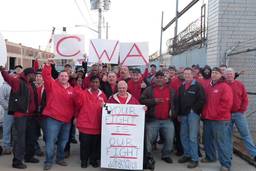Sen. Harkin criticizes White House for delaying new workplace safety rules
WASHINGTON, D.C. — Republicans typically accuse Democats of not doing enough to streamline regulations. But at a hearing on Capitol Hill last week, Republican senators defended the Obama administration against criticism from labor leaders and workplace safety advocates who say the administration has made it too cumbersome to create and issue new workplace safety rules.
The April 19 Senate hearing, titled “Time Takes Its Toll: Delays in OSHA’s Standard-Setting Process and the Impact on Worker Safety,” focused on why it takes so long for workplace safety rules issued by OSHA to be implemented. It coincided with the release of a report by the Government Accountability Office (GAO).
The GAO report found that between 1981 to 2010, the time it took OSHA to develop and issue safety and health standards ranged from 15 months to 19 years, averaging more than seven years. The report found it took OSHA 50 percent longer than it takes the EPA to issue new rules, nearly twice as long as it takes the Department of Transportation and nearly five times as long as it takes the SEC. Twenty-five percent of all OSHA rules took more than 10 years to be issued, the GAO said. The increasingly slow process has limited the number of OSHA rules implemented (PDF) in recent years.
“The Reagan Administration issued new rules at a rate four-times faster than the current administration,” said Senate Committee on Health, Education, Labor and Pensions Chairman Tom Harkin (D-Iowa), whose father, a coal miner, died of black lung. “I suspect that the lack of new rules is at least partly the result of relentless external pressure from business lobbyists and anti-labor groups. These groups pressure both OSHA and the OMB [Office of Management and Budget] to create delays that costs lives.”
The OMB, controlled by the president, reviews every rule issued by a federal agency before that agency is allowed to implement them.
The GAO report blamed the rule delays on a series of additional outside reviews and analyses done by the (generally business-friendly) Office of Management and Budget and the Small Business Administration (SBA). OSHA is one of only three agencies required to run their rules by the SBA. The report found that additional reviews, which often duplicate long scientific analyses done by other agencies, lengthen the process.
If a rule change is challenged, OSHA must be able to legally demonstrate to a court that there was substantial evidence for why it set the rule, whereas other agencies are held to a lower standard, only having to demonstrate that a rule was not “arbitrary or capricious.” This higher legal barrier requires OSHA to spend additional years studying and documenting conclusively why a problem occurs so that corporations are unable to change these rules
“Why it takes 19 years to set a scaffold standard doesn’t necessarily make sense,” said Revae Moran, director of the GAO’s Education, Workforce and Income Security group.
The U.S. Chamber of Commerce is happy with the current criteria for OSHA safety standards. The Chamber’s David Sarvadi said the agency
must establish, based on the evidence in the official rulemaking record, that current conditions pose a significant risk of material harm to workers, that the proposed rule would significantly reduce the risk, that the proposed rule is technically and economically feasible for each industrial sector and activity regulated by the rule and, at least in theory, that the proposed rule provides the most cost-effective approach for addressing that hazard.
At one point during the Senate hearing, GOP Sen. Mike Enzi (R-Wyo.) claimed unions may be responsible for the poor state of workplace safety, saying that he heard that unions fine workers for reporting safety problems. (Video of the hearing is here.)
Critics of the status quo say the requirements placed on OSHA undermine workplace safety. “In the years since its creation, OSHA’s charge to protect workers from harm has been undermined by Kafkaesque demands for additional reviews of existing rules mandated by new statutes and executive orders,” Randy Rabinowitz, OMB Watch’s Director of Regulatory Policy, said at the Senate hearing.
The hearing focused on how the OMB — specifically, its Office of Information and Regulatory Affairs, directed by Cass Sunstein — has recently held up several proposed rules beyond the time that OMB is allowed to review them, which is about four or five months.
For example, as I reported in February, the OMB has been reviewing for more than a year a proposed OSHA rule that would limit workers’ exposure to cancer causing silica dust. A study by Public Citizen estimates that, in the time that the rule has been held up by OMB, 60 workers’ live could have been saved should the rule have been implemented.
After the hearing, Sen. Harkin told me, “I have some real questions about OMB. Why are they holding things up as long as they are and why they are doing it in secret? This process needs to be opened up.” Harkin said he would be speaking with his staff about this issue and that he assumed his staff would bring up some of these issues with the Obama administration.
Later in the day, families of workers who had been killed on the job and workplace safety advocates met with Sunstein to discuss workplace safety rules.
“It was a historic meeting from all of our recollections.This is the first time that injured workers and families that have lost loved ones have met with head of the Office of Information and Regulatory Affairs,” says Celeste Monforton, who lectures at George Washington University’s School of Public Health, who attended the hearing. “In watching his expression [during the meeting[, he seemed quite moved and frankly overwhelmed by these family members’ statements.”
But many remain skeptical that a tighter regulation is going to be issued on silica dust anytime soon.
“There is a toxic environment in this country funded by powerful interests who have convinced lawmakers that the way they win an election is to oppose regulation. It’s a very important election year and there is so much rhetoric about how regulation kills jobs,” Monforton says. “It doesn’t surprise me that the incumbent president is extremely cautious about putting out something that would be immediately be attacked in an election year.”









